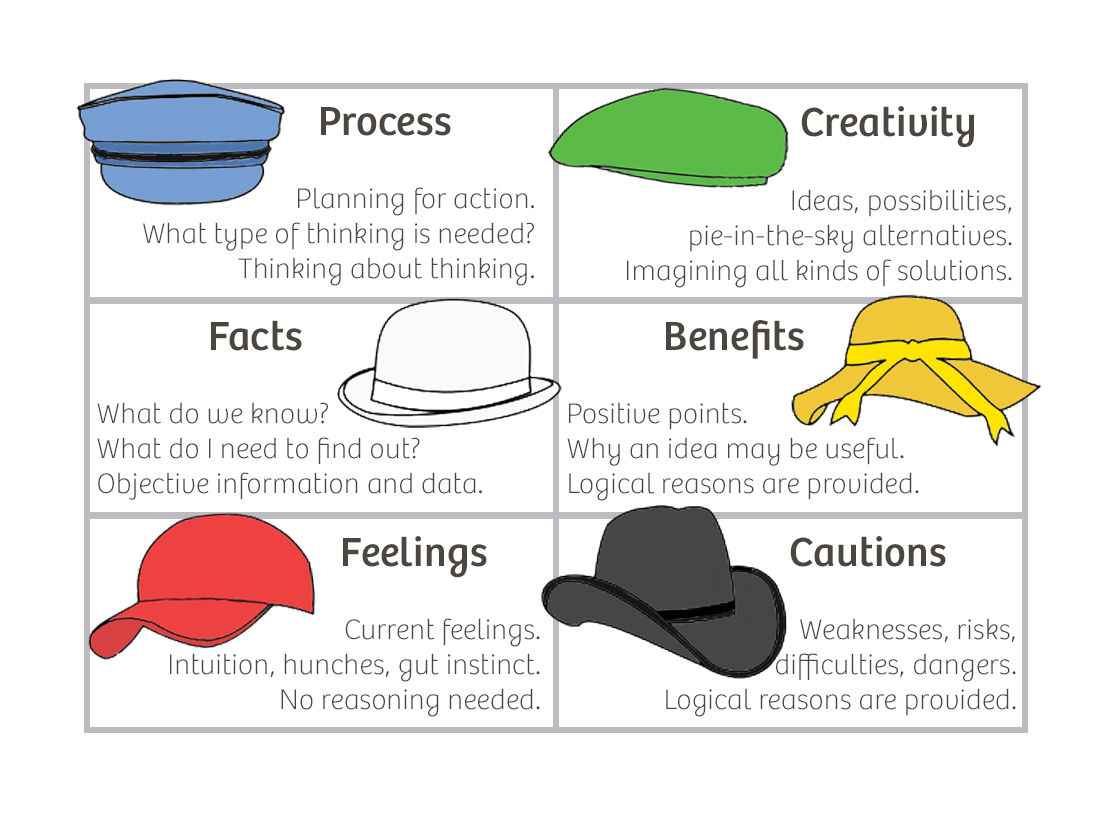Learn about the 6 thinking hats method
“6 thinking hats” is a method to support decision making based on different perspectives and perspectives. Accordingly, 6 hats (white, red, black, yellow, green and blue) represent 6 perspectives (data, intuition, negative, positive, creative, general) to share about the same problem.

Features of the 6 thinking hats
1. White Hat (Fact)
The white hat represents thinking based on factual data and grounded, objective, and rational information. The person in the white hat will give opinions based on data such as revenue, number of customers, turnover rate, new hire rate... for the month. This person will not give opinions or comments from his personal perspective.
Questions to use:
- What information do people have on this matter?
- What information is directly relevant to the issue under consideration?
- What information and data have we missed?
2. Red Hat (Feelings)
In contrast to the white hat, the person wearing the red hat will represent intuitive and emotional thinking. At this point, you just need to rely entirely on your emotions to evaluate things without any factual data or proof. With the red hat thinking method, you will easily understand the thoughts and reactions of others.
Questions to use when thinking red hat:
- Do I like this problem, the solution?
- How are you feeling right now?
- Intuition tells me what to do?
3. Black Hat (Cautions)
The black hat will represent thinking in the direction of analysis and finding out the risks, errors, irrationalities ... of the problem being discussed. In the method of 6 thinking hats, black hat thinking will be suitable when you want to identify weaknesses in your solution or want to analyze the level of risk of a project. Based on that information, you will make adjustments or make contingency plans to not affect the work.
Questions to use:
- What are the risks when implementing this project?
- Difficulties encountered when implementing?
- What potential risks will the Company/Department/I face?
4. Yellow Hat (Benefits)
The yellow hat represents the most positive thinking among the six hats. Accordingly, when wearing a yellow hat, you will give optimistic, positive comments and statements to the company to give more motivation and confidence to the listeners. Thanks to this optimism, it will help you/colleagues become more confident and not miss the opportunities that can be obtained if implementing the project.
Some questions to use when thinking in yellow hat:
- What are the results we will achieve as we proceed with this/project?
- What is the positive view of this issue?
- We will do but for how long?
5. Green hat (Creativity)
The green hat represents creative thinking in the six thinking hats method. Therefore, the person wearing this hat will need to think in a new way that no one has ever mentioned to solve the problem. This way of thinking may or may not have effective solutions, but you should not ignore to diversify solutions as well as practice creativity, avoiding having to go into the available ruts.
Some questions should apply:
- Is there another way to do it?
- If you do it differently, is there a better way to do it?
- Has anyone done this method?
6. Blue Hat (Process, Control)
Of the six thinking hats, the blue hat plays a management role to coordinate the organization and control the other hats. The person wearing this hat is usually the chairperson in meetings or discussions, whose task is to receive, analyze the stated statements and make the final decision.
Questions to apply when thinking green hats:
- What are we sitting here for?
- What rules do we need to agree on?
- What is the order of development of the representatives of the hat?
- Who gathers all the opinions, summarizing?
- What was the outcome of the meeting?
- When is the time to start taking action?
- Is the information enough to solve the problem?
Principles of the 6 thinking hats method
According to sharing from Dr. Edward de Bono, to apply the six thinking hats method effectively, you need to assume that you put on each hat in turn and evaluate a problem. Then, each hat will correspond to a separate way of thinking. And because in 6 hats there are 3 pairs of opposing hats, corresponding to different aspects of decision making, so you can completely combine to think at the same time.
- White - Red Pair: Thinking rationally and emotionally
- Black-gold pair: Think in the direction of pessimism and optimism.
- Green – Blue Pair: Creative and Principled Thinking
Steps to apply the 6 thinking hats method
In fact, a person's way of thinking will go in a certain direction depending on the living environment as well as personal experience. This will greatly affect the analysis process as well as give a solution to a problem.
So, for the 6 thinking hats method to be effective, you need to follow a certain sequence of steps:
Step 1: Put on a white hat and think based on facts and evidence. This will help you make unbiased, grounded judgments and remove all biases and arguments.
Step 2: Put on the green hat and think in terms of solutions using more creative methods.
Step 3: Assess the value of the ideas that you have given when you put on the green hat and use yellow hat thinking to list the benefits that can be received. Then, apply black hat thinking to analyze and find out the risks and problems that may be encountered in the implementation problem.
Step 4: Apply red hat thinking to visualize the listener's reactions, emotions, and feelings. From there, you can always find a solution to deal with when encountered.
Step 5: Apply blue hat thinking to synthesize the problem comprehensively, conclude the solution and make the best decision.
The six thinking hats method is a method that has been developed and taught by many large organizations in the world such as IBM, Pepsi, Polaroid, Federal Express, British Airways, Prudential, Dupont, etc. Therefore, you can learn and apply it in work as well as in life.












Replies to This Discussion